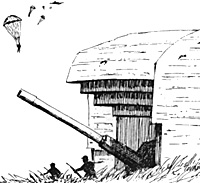 Back in PF #54 Mr. Lowry presented several ways to add simultaneous movement to D-Day
but did not cover some of the rules like those covering parachutists. So for those
of you who don't have PF #54 or would like more complete rules for this variant here they are.
Back in PF #54 Mr. Lowry presented several ways to add simultaneous movement to D-Day
but did not cover some of the rules like those covering parachutists. So for those
of you who don't have PF #54 or would like more complete rules for this variant here they are.
I. Initial set uf)/first turn special rules
- 1.The German player sets up all his units upside-down.
2. The Allied player may look at all units on coastal squares and up to two squares inland in three of the invasion areas.
3. The German player may not move during the first two phases of movement during the first turn.
II. Movement
- 1. Divide each turn into four phases
- a. Units with four movement factors can move one hex in each phase.
b. Units with three movement factors can move one hex in each of the first three ohases, but cannot move in the fourth phase.
c. Units with two movement factors can move one hex in the second and third phases but can't move in the first and fourth phases.
d. Movement into a mountain hex consumes all remaining movement factors for that turn.
2. Procedure: Each player writes out his moves before each phase and then these are exposed simultaneously.
III Invasions
- 1. All Allied units may only conduct an invasion in the first phase of movement and they can't move for the rest of the turn - Exception; Parachutists which air dropped in may move one square in the third movement phase.
IV. Combat
- 1.Combat occures when two units try to move into the same hex at the same time, in which case the one with the most attack factors is the attacker and the other unit uses its basic defense strength no matter what the terrain.
2. If a unit attempts to move into a square occupied by an enemy unit it is the attacker and the enemy unit is the defender and is able to utilize any terrain advantages.
3. So that you can have higher odds and so that the game is more realistic you may conduct an attack as in two above using several units, however after the attack, you may only move in as many as stacking limitations permit and the others must stay in their original hexes.
V. Parachutists
- 1. A para-unit may be dropped at the beginning of any of the first three movement phases. It may not be moved in the phase it is dropped and it may only be dropped once in a turn.
2. If a unit paradrops a movement point is used up, so under no conditions is it possible for a parachute unit to move in phase 4.
3. A parachute unit may drop in an enemy zone of control in which case it has combat with all adjacent enemy units.
4. If a German unit moves into a hex in the same turn that a para-unit drops on that hex the parachute unit conducts an attack as in two above except that German losses take place first in the hex which is occupied by German and parachute units.
5. The only Time Allied and German units can coexist in the same hex is when an accident in the paradrop like in three above happens.
Tournament Rules
I. Sea Movement
- 1. The Allied player may embark at the BEGINNING of any movement phase in which he could regularly move (therefore parachute units couldn't embark on phase 4)
2. The Allied player must debark his units on either the fourth or fifth phase after embarkment and at the beginning of the phase.
3. An Allied unit may move no further than its debarkment square on the phase of debarkment.
II. Supply
- 1. An Allied unit may now go beyond the 17 square supply limit but if he does his movement, attack and defense factors are cut in half with fractions rounded upward, this takes effect in the TURN after the unit moves out of supply.
III. Air power
- 1. Air attacks take place at the beginning of any phase but in addition to the 2 a week limitation there is also a one a phase limitation.
IV. Reconnaissance (Optional)
- 1. Keep your counters upside-down and utilize an agreed upon number of blank counters if so desired.
2. You may examine an enemy's stack whenever he passes in your zone of control.
3. Because of his air superiority the Allied player may examine any two German stacks on the board, one in the first phase and one at the beginning of the third phase of each turn.
Back to Table of Contents -- Panzerfaust #62
To Panzerfaust/Campaign List of Issues
Back to MagWeb Master Magazine List
© Copyright 1974 by Donald S. Lowry
This article appears in MagWeb (Magazine Web) on the Internet World Wide Web. Other military history articles and gaming articles are available at http://www.magweb.com